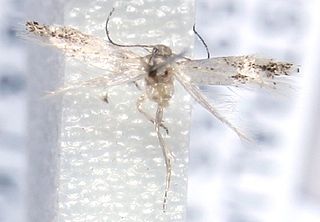
The Elachistidae are a family of small moths in the superfamily Gelechioidea. Some authors lump about 3,300 species in eight subfamilies here, but this arrangement almost certainly results in a massively paraphyletic and completely unnatural assemblage, united merely by symplesiomorphies retained from the first gelechioid moths.
Elachista crocospila is a moth of the family Elachistidae. It is found in Australia in south-eastern New South Wales.
Elachista asperae is a moth of the family Elachistidae. It is found along the coast of New South Wales, Australia.
Elachista coalita is a moth of the family Elachistidae first described by Lauri Kaila in 2011. It is found in south-eastern Australia, including the Australian Capital Territory, New South Wales and Tasmania.
Elachista floccella is a moth of the family Elachistidae. It is found in Australia in the Australian Capital Territory, New South Wales and Tasmania.
Elachista eriodes is a moth of the family Elachistidae. It is found in the Australia state of New South Wales and on the Fleurieu Peninsula in South Australia.
Elachista patania is a moth of the family Elachistidae. It is found in the coastal areas of south-western Western Australia.
Elachista averta is a moth of the family Elachistidae. It is found in Australia in eastern New South Wales and Queensland.

Elachista stictifica is a moth of the family Elachistidae. It is found in Australia.

Elachista zophosema is a moth of the family Elachistidae that is found in Australia, where it has been recorded from higher altitudes in Tasmania.

Elachista impiger is a moth of the family Elachistidae. It is found in Australia.
Elachista miscanthi is a moth of the family Elachistidae. It is found in the Japanese island of Honshu and Kyushu and in Taiwan.
Elachista acenteta is a moth of the family Elachistidae. It is found in North America in Nova Scotia, Ontario, Quebec, Colorado and Nebraska.
Elachista adempta is a moth of the family Elachistidae. It is found in North America in Alberta, Saskatchewan, Colorado, Nebraska, Nevada, Utah and Wyoming.
Elachista caliginosa is a moth in the family Elachistidae. It was described by Parenti in 1983. It is found in Japan (Honshu) and the Russian Far East.
Elachista bipunctella is a moth in the family Elachistidae. It was described by Sinev and Sruoga in 1995. It is found in south-eastern Siberia and Japan. The habitat consists of boggy areas.
Elachista nitensella is a moth in the family Elachistidae. It was described by Sinev and Sruoga in 1995. It is found in Japan and the Russian Far East.
Elachista similis is a moth in the family Elachistidae. It was described by Sugisima in 2005. It is found in Japan.
Elachista hiranoi is a moth in the family Elachistidae. It was described by Sugisima in 2005. It is found in Japan.
Elachista fasciocaliginosa is a moth in the family Elachistidae. It was described by Sugisima in 2005. It is found in Japan(Honshu).



